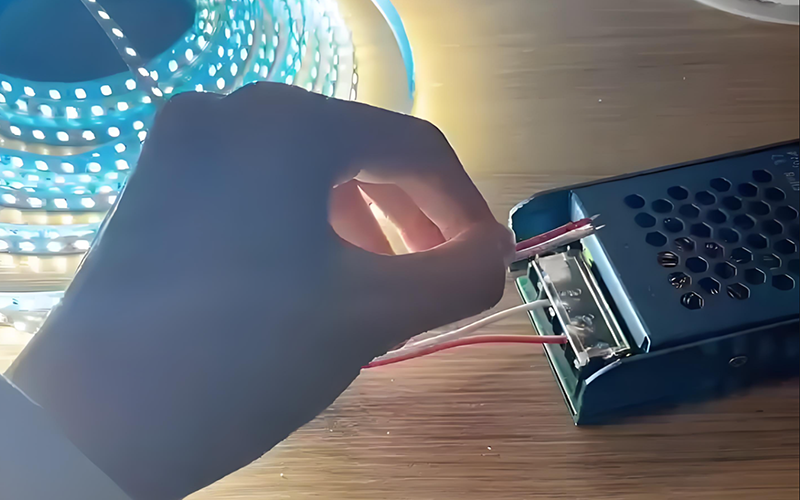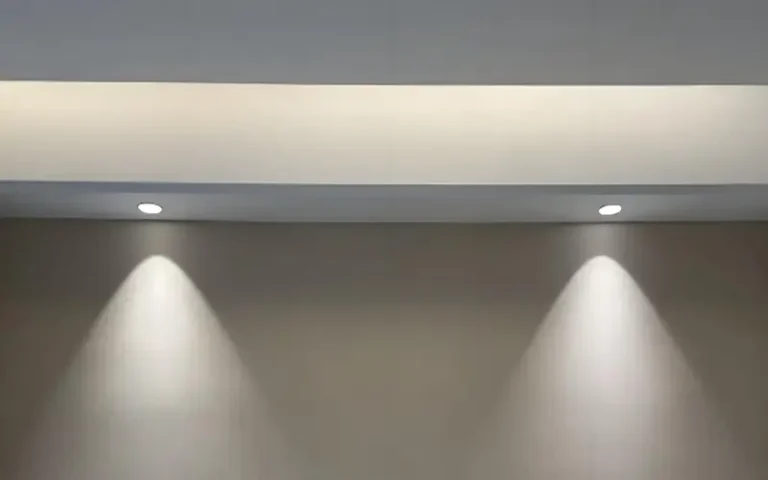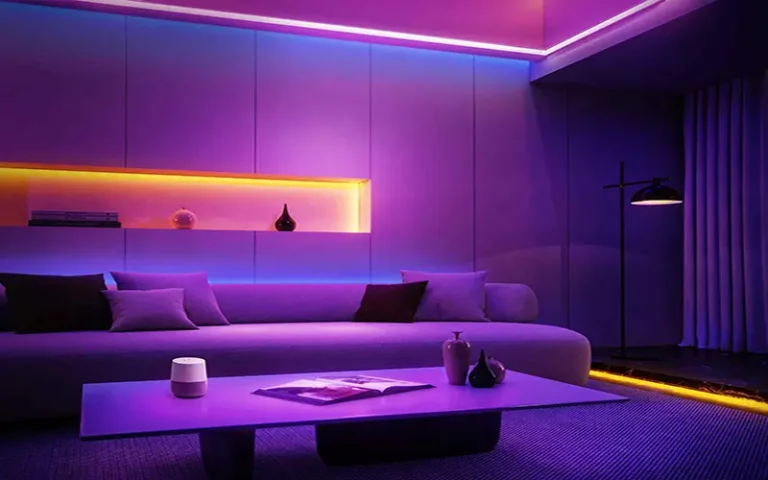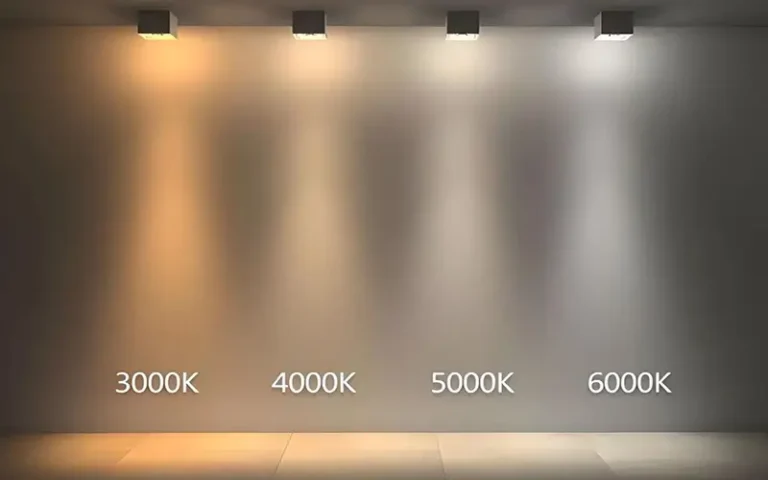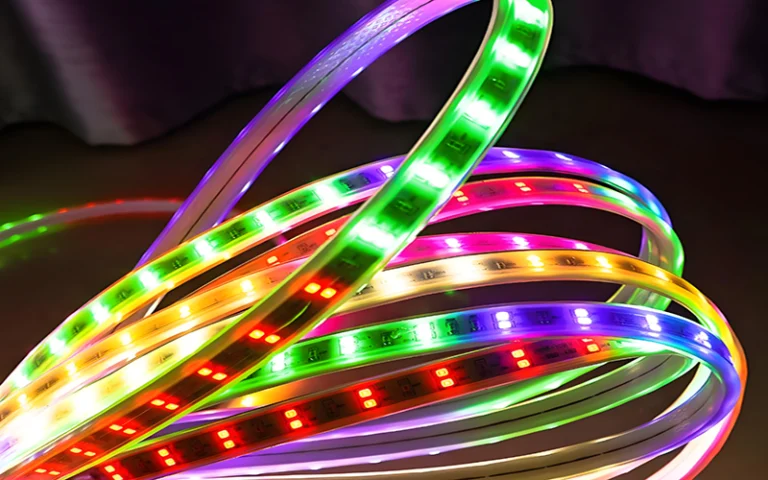What is LED Strip Voltage Drop?
Anyone who has ever bought an LED strip knows about voltage drop. And voltage drop is a common problem in LED strip lighting installations. Especially in the case of long LED strips, it will directly affect the performance, brightness and even life of the lights.
There are many reasons for voltage drop in LED strips. In short, voltage drop is the voltage drop as it flows along the length of the LED strip, causing the light at the far end to be dimmer than the starting end. Let’s analyze the causes of voltage drop and how to avoid voltage drop in LED strip.
How Does Voltage Drop Affect LED Strip Performance?
Voltage drop occurs when current flows through a circuit resistor, reducing the voltage supplied to the circuit. For LED strips, this resistance comes from the LED components themselves and the wires used to connect them.
As the voltage drops, the LEDs at the ends of the strip receive less power, resulting in reduced brightness and performance. The specific manifestations are as follows:
1. Uneven brightness
The most direct manifestation is that the voltage drop will cause the LED light strip to have uneven brightness. Specifically, because the voltage will encounter certain resistance when flowing through the light-emitting lamp beads, circuit boards and other components, the voltage gradually decreases, so that the LED lamp beads close to the power supply end have higher brightness, while the LED lamp beads far from the power supply end have lower brightness.
This phenomenon is especially obvious in low-voltage LED light strips (such as 12V and 24V LED strips). Generally, the length of 12V LED strips does not exceed 5 meters, and the 24V LED strips will face the same situation after exceeding 10 meters.
2. Decreased brightness
A drop in voltage will also cause the overall brightness of the LED strip to decrease. The voltage reduction will reduce the current passing through the LED lamp beads, thereby reducing the luminous intensity of the LED lamp beads and reducing the brightness of the entire LED strip.
3. Shortened lifespan
If the LED light strip works in an unstable voltage environment for a long time, it will accelerate the aging of the LED lamp beads and circuit boards. This will shorten the service life of the LED light strip.
In addition, if the voltage is too low, it may also cause the LED strip to fail to work properly, further affecting its service life.
4. Impact on visual effects
The uniformity and consistency of LED light strips are very important. In situations where uniform lighting is required, such as commercial displays, home decoration, etc., uneven brightness of LED light strips will seriously affect the visual effect and reduce the overall aesthetics.
Calculating Voltage Drop: A Simple Formula
To calculate the voltage drop, you need a rough calculation. You can use the following formula:
Voltage Drop = Current (I) × Resistance (R) × Length (L)
- Current (I): The amount of current flowing through the circuit, measured in amperes (A).
- Resistance (R): The resistance of the wire, measured in ohms (Ω).
- Length (L): The length of the wire, measured in feet or meters.
Why Does LED Strip Lights Voltage Drop?
We need to understand the causes of voltage drop in LED strips so that we can prevent voltage drop in advance.
LED strips are used for too long:
The problem of voltage drop of LED strips generally occurs on low-voltage LED light strips. Generally, 12V is used for no more than 5 meters, and 24V is used for no more than 10 meters. When you meet choose voltage of LED strip, pls read Which is Better, 12V vs 24V LED Strip Lights?
As the length of the LED strip increases, the distance that the current must flow also increases, increasing the possibility of voltage loss along the way.
Insufficient Wire Gauge
Where the power source is connected, thicker copper wire is needed. Thin wire has a higher resistance, which causes a more noticeable voltage drop. Using a wire gauge that is too small for the length and power requirements of the strip can exacerbate this problem.
Poor Connections
When we connect LED light strips, we need to secure each connection. Loose or poor quality connections increase resistance, further reducing the voltage over the length of the light strip.
Low-quality LED strips
You need to choose high-quality LED strips. Not all LED strips are made with the same materials or manufacturing processes.
Poor-quality strips often lack sufficient copper in the circuit paths, which increases resistance and causes more significant voltage drop issues.
Power Supply Distance
The installation location of the power supply should also be planned in advance. It should not be too far away from the LED light strip and should be placed in a dry and ventilated place.
When the power supply is far away from the LED light strip, the wiring between them may lose additional voltage, which will aggravate the voltage drop.
By addressing these reasons and carefully planning the installation, the risks associated with voltage drops in LED light strip installations can be minimized.
How to Minimize Voltage Drop in LED Strip Installations?
Before you even think about installing an LED strip, you need to consider this voltage drop issue. Here are some tips for you to consider.
Add power points
For longer LED strip projects. Whether it is 12V or 24V, voltage drop can be reduced by adding power points. More details, pls read 12V or 24V LED Strip, Which is Better?
For example, adding a power supply in the middle of the strip and using a dual-end power supply solution can effectively avoid voltage drop issues.
Determine the correct wire gauge
Wire gauge is one of the main considerations for reducing voltage drop. Thicker wires (lower gauge numbers) have lower resistance and are therefore better suited for longer LED strip installations.
Choosing the right gauge wire is especially important when powering high-current LED strips or wiring long distances.
Choose the right power supply
Using a power supply that can handle the current demands of the LED strip setup is critical to avoiding voltage drops. An under powered power supply will result in inconsistent lighting and cause premature degradation of the LEDs. How to choose the right power supply, pls read How to Choose LED Power Supply for LED Light Strips?
For long-distance wiring, consider using multiple power supplies or injecting power at various points in the strip.
Running LED Strips in Parallel
For installations that require long LED strips, consider running them in parallel rather than in series. Connecting multiple shorter strips in parallel to the same power source shortens the length of each run, minimizing the risk of voltage drops.
This approach also allows each segment to receive a consistent voltage, helping to keep brightness even across the installation.
Conclusion
By understanding the factors that cause voltage drop in LED strips and implementing effective mitigation strategies, you can ensure your LED light strip installation provides optimal performance and longevity.
By carefully considering the power source, wire gauge, and overall installation practices, you can minimize voltage droop and realize the full potential of your LED lighting project.
FAQs
The main causes of voltage drop in LED strips are caused by the resistance of the copper wire, the length of the LED strip, and the current flowing through it. When the current flows along the strip, some energy is lost as heat due to this resistance. Especially longer strips or strips with higher power requirements have more significant voltage drops.
There are many reasons for voltage drop in LED strips. To prevent voltage drop in LED strips, we try to use thick wire with lower resistance as much as possible. In addition, shorten the length of the LED strip as much as possible. And use a higher voltage power supply and convert it to the correct voltage for the LEDs, etc.
If the voltage drop of the LED strip is too large, the most intuitive effect is uneven lighting and may affect the overall performance of the LED strip. The LEDs at the far end of the strip will be dimmer than the LEDs closer to the power supply. In extreme cases, excessive voltage drop can damage the LEDs or cause them to stop working completely.
To maintain optimal lighting quality and efficiency, the maximum voltage drop allowed for LED strips is typically around 5-10%. If the voltage drop exceeds this, noticeable dimming or performance issues will result.
24V LED strips are generally better at handling voltage drop than 12V strips. We recommend that 12V strips be used up to 5 meters, while 24V strips are used up to 10 meters. Therefore, 24V strips can maintain consistent brightness over longer distances, reducing the need for power injection or additional measures to minimize voltage drop.

